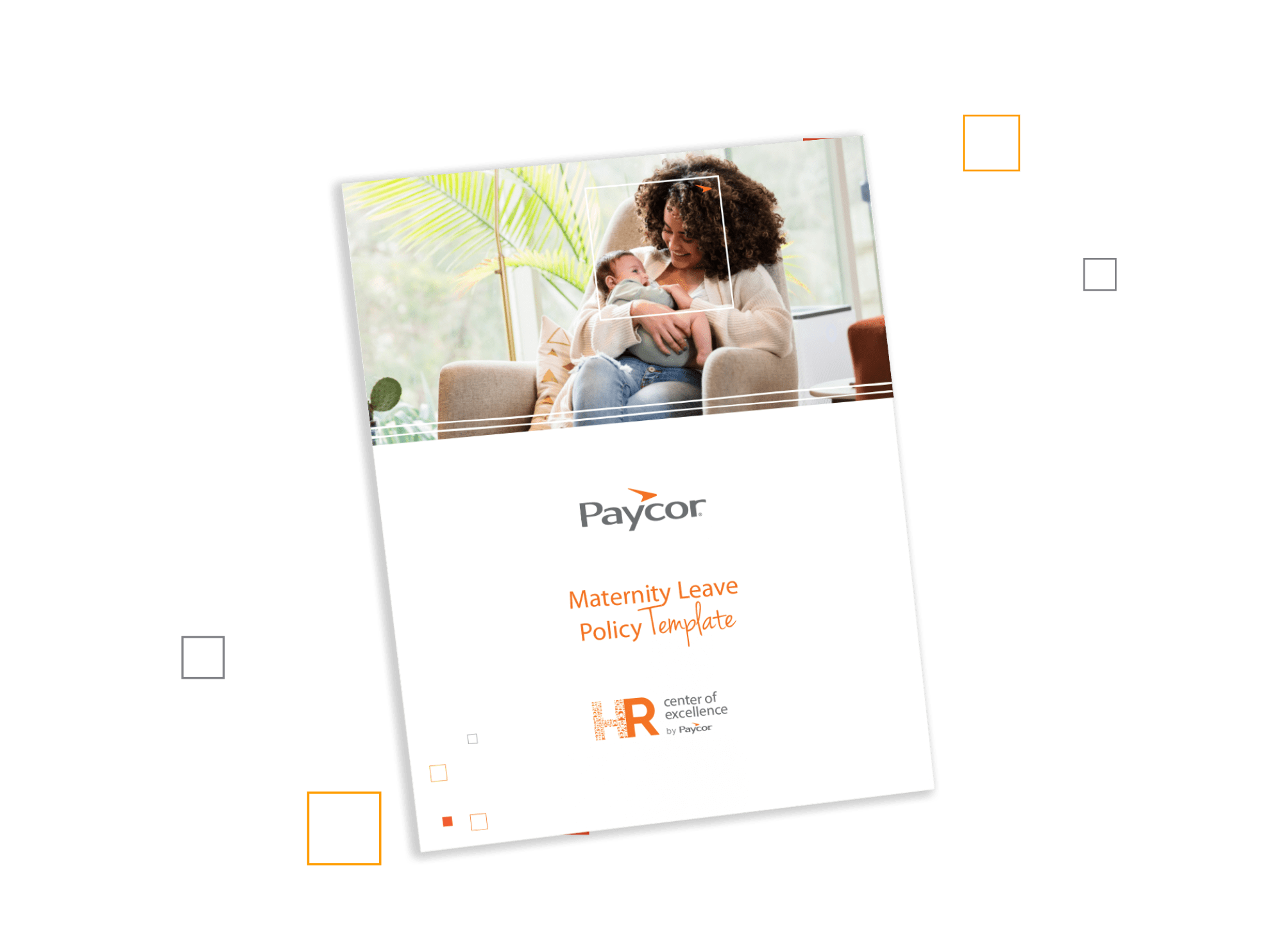Companies that offer parents leave when they have or adopt a child have been shown to improve employee engagement and retention. The benefit also helps prevent a gender imbalance in the workplace. However, U.S. maternity leave law varies by state and industry and many workers still don’t have any access to paid parental leave.
Whether a parent is guaranteed time off varies state by state, and often depends on a company’s size and location. Companies with 50 or more employees must offer FMLA leave, though there are more extensive plans required in many states, some of which also cover smaller companies.
What is Maternity Leave?
The United States has no national policy for maternity leave, but several states have mandated a maternity leave policy on their own. Depending on the state leave may also be taken by fathers and after a child is adopted or fostered. Often maternity leave is covered by parental leave laws, but in other cases these rights only apply to mothers, not fathers.
Federal Law on Maternal Leave
While not a formal maternity leave policy (Get Our Free Maternity Leave Policy Template), The Family and Medical Leave Act (FMLA) offers eligible employees 12 weeks of unpaid leave per year, with employment reinstatement rights, in various circumstances, which include the birth of a child, caring for a newborn and incapacity due to pregnancy. The law applies to federal employees, state workers and private companies; however, employees are only eligible if they work for companies that have 50 or more employees and have completed at least 1,250 hours of work in the previous year.

Maternity Leave Policy Template
Offering maternity leave to your employees is a valued benefit. Create your maternity leave policy with ease by using our free template.
What States Have Paid Maternity Leave?
Many states go further than federal law when it comes to maternity leave. Some extend FMLA entitlement to smaller companies, while others guarantee paid leave. These policies differ according to eligibility, length of leave, and, if paid, how they are funded. In several states, pregnancy and childbirth qualify mothers for short-term disability benefits.
While not necessarily guaranteeing leave, other states require that pregnancy be treated as a temporary disability and so if a company provides paid leave for those with other temporary disabilities, they must do the same for pregnant employees.
Now, let’s break down leave laws for parents wherever you do business.
| State | Unpaid Leave Beyond FMLA? | Who Is Eligible for Paid Leave? | How Long Does Paid Leave Last? | How Much Do Employees Receive? |
|---|---|---|---|---|
| Alabama | No | – | – | – |
| Alaska | No | – | – | – |
| Arizona | No | – | – | – |
| Arkansas | No | – | – | – |
| California* | Private and public sector employers must provide up to 12 weeks unpaid family leave plus 4 months of maternity disability leave for a total of 28 weeks per year. | Part- or full-time employees in public or private sector who have contributed to the Disability Insurance Elective Coverage at some point in the previous 18 months. Does not provide job protection. | 8 weeks | 60 to 70% of wages earned 5-18 months before claim start date. For claims beginning on or after 1/1/22, weekly benefits range from $50 to $1,540. |
| Colorado | Yes, begins January 2024. | Colorado employees who have earned at least $2,500 in wages within the state within the last 4 calendar quarters. Self Employed Workers (1099 or Contract Workers) may also be eligible if they have opted into coverage and live and work in Colorado. | Under FAMLI, workers can receive 12 weeks of paid leave + the potential for 4 additional weeks for childbirth complications. | Leave will be paid at a rate of up to 90% of the employee’s average weekly wage. |
| Connecticut | All pregnant and adoptive employees entitled to 12 weeks unpaid in rolling 12-month period. | Employed for at least 12 months and worked at least 1,000 hours in the preceding 12-month period. | 12 weeks. | Up to 95% of weekly pay. |
| Delaware | Yes. State-mandated paid leave begins January 2026 | Employees who have worked for the same employer for at least 12 months and worked at least 1,250 hours in the prior 12 months | 12 weeks | 80 percent of the covered individual’s average weekly wages. |
| District of Columbia | Employees can take up to 16 weeks of unpaid leave in a 24-month period. | D.C. Employees receive 12 weeks for the birth or adoption of a child. | Up to 14 weeks. 12 weeks for bonding and 2 weeks for prenatal care. | Up to $1,000 per week. Funded by employer tax. |
| Florida | No | – | – | – |
| Georgia | No | – | – | – |
| Hawaii | Employers with 100+ employees must offer up to 4 weeks each calendar year. | Through Temporary Disability Insurance. Employee must have 14+ weeks of employment in the state, be paid for 20 or more hours and earn no less than $400 in the year preceding the first day of disability. 14 weeks does not have to be consecutive and can be with one or more employers. | Duration spent physically disabled due to pregnancy/childbirth (usually 6-8 weeks. Up to 6 months). | 58% of average wages. Employers must maintain private coverage or self-insure. |
| Idaho | No | – | – | – |
| Illinois | Yes. State-mandated paid leave begins January 2024 | Any Illinois worker | 40 hours under the Paid Leave for Workers Act | Employee to receive the normal hourly rate of pay. |
| Indiana | No | – | – | – |
| Iowa | Companies with 4+ employees must offer 8 weeks unpaid leave. | – | – | – |
| Kansas | – | – | – | – |
| Kentucky | 6 weeks of unpaid leave available to employees who adopt a child. | – | – | – |
| Louisiana | Companies with 25+ employees must provide 6 weeks of leave (+ 4 months for a pregnancy-related disability). | – | – | – |
| Maine | Companies with 15+ employees must offer 10 weeks unpaid leave in a 2-year period. | – | – | – |
| Maryland | Companies with 15-49 employees must offer 6 weeks unpaid parental leave under MPLA. | All Maryland employee parents of any gender, including foster and adoptive parents (full-time and part-time + private and public sector workers.) | Up to 12 weeks of paid leave (24 in some circumstances). | Up to 90% of their income. |
| Massachusetts | Companies with 6+ employees must offer 8 weeks unpaid leave for birth or adoption. | – | – | – |
| Michigan | No | – | – | – |
| Minnesota | Companies with 21+ employees must provide 12 weeks unpaid leave within 12 months of birth or adoption. Employee must have worked at least part-time for the employer for 1 year prior to the request. | – | – | – |
| Mississippi | No | – | – | – |
| Missouri | No | – | – | – |
| Montana | All female employees of public employers are entitled to a “reasonable leave of absence for pregnancy,” which translates to up to 6 weeks. Fathers and adoptive parents can take up to 15 days for parental leave. | – | – | – |
| Nebraska | No | – | – | – |
| Nevada | No | – | – | – |
| New Hampshire | Employers with 6+ employees must grant unpaid leave for temporary disability due to pregnancy. There is no set time limit for leave. | If the employer allows paid leave for other illnesses, it must allow the same for pregnancy. | – | – |
| New Jersey | Companies with 50+ employees must offer 12 weeks unpaid leave in a 24-month period. Eligible employees must have worked at least 1 year and at least 1,000 hours for the employer. | All employees. Paid through state temporary disability insurance. | 12 weeks during and after pregnancy plus an additional 12 weeks for parental leave for birth and adoptive parents. | Up to 2/3 regular wages. Temporarily Disability is funded by employee + employer contributions; Family Leave is funded by payroll deductions. |
| New Mexico | No | – | – | – |
| New York | All private sector employers must offer 10 weeks unpaid leave. | All private sector employees who have worked at least 26 weeks get 12 paid leave weeks. | Typically 6-8 weeks for disability due to pregnancy and a further 12 weeks of parental leave once for new parents. | Temporary Disability: Up to 50% of salary (up to $170 per week). Funded by employee + employer contributions. Parental Leave: Up to 67% of average salary (up to $840.70 per week). Funded by payroll deductions. |
| North Carolina | No | – | – | – |
| North Dakota | Applies only to state employees. Up to 12 weeks during a 12-month period. | – | – | – |
| Ohio | No | – | – | – |
| Oklahoma | No | – | – | – |
| Oregon | Companies with 25+ employees must offer 12 weeks unpaid leave in any 1-year period for both pregnancy disability. An additional 12 weeks each can be taken for parental leave and sick child leave for a total of 36 weeks. | – | – | – |
| Pennsylvania | No | – | – | – |
| Rhode Island | Companies with 50+ employees must offer 13 weeks unpaid leave in any 2 calendar years. | All employees through state temporary disability insurance. | Temporary Disability Insurance for the duration of disability due to pregnancy, followed by 4 additional weeks for new mothers. Up to 30 weeks. | Minimum of $114 per week up to $978 per week. Funded by employee wage deductions. |
| South Carolina | No | – | – | – |
| South Dakota | Applies only to state employees. Up to 12 weeks during a 12-month period. | – | – | – |
| Tennessee | Companies must offer 4 months unpaid leave. | Offering paid leave is up to the employer’s discretion. | – | – |
| Texas | No | – | – | – |
| Utah | No | – | – | – |
| Vermont | Companies with 10+ employees must offer 12 weeks unpaid leave in a 12-month period. | – | – | – |
| Virginia | No | – | – | – |
| Washington | All employers must offer paid leave but only those with 50+ employees must offer job protection. | All employees (with minimum 820 hours worked). | 12 weeks (or more in the case of complications). | 90% of wages up to $1,000 per week. Funded by employee + employer contributions. |
| West Virginia | Companies with 12+ employees must provide reasonable accommodation, including time off, for pregnant employees who need them. Employee must have worked at least 12 weeks. | – | – | – |
| Wisconsin | Employers with 50+ employees must provide 6 weeks for birth or adoption plus 2 weeks to care for a family member. Employees can take an additional 2 weeks for their own health condition. | – | – | – |
| Wyoming | Up to employer’s discretion. | Up to employer’s discretion. | – | – |
| Puerto Rico | When medically necessary, employee can qualify for 12 weeks unpaid leave (in addition to paid leave). | Employees of private companies. | Generally 8 weeks: 4 weeks before and 4 weeks after birth. | Up to $113 per week. Funded by Employee + employer contributions. |
*This entry refers to state-wide California law. Cities and municipalities within California may offer extended benefits.
What Is Paid Family and Medical Leave (PFML)?
Paid family and medical leave (PFML) provides unpaid or paid time off (on average 6-12 weeks in a 12-month period) to be used for:
- an employee’s serious health condition
- to care for a family member with a serious health condition
- to care for or bond with a new child
- for reasons related to a family’s member’s military service
Paid family and medical leave may be provided through temporary disability insurance which is funded by contributions from the employer and/or the employee.
How long is maternity leave in the U.S.?
After exhausting 12 weeks of Family and Medical Leave Act (FMLA) benefits, there is no U.S. maternity leave program. The amount of additional paid or unpaid leave that is available is dependent on state law and, where no state law exists, is up to the employer’s discretion.
Is maternity leave paid by employer or government?
The Family and Medical Leave Act is 12 weeks of unpaid leave with job protections. Paid maternity leave is often voluntarily provided by employers; however, several states (California, Colorado, Connecticut, Delaware, Massachusetts, Maryland, New Jersey, New York, Oregon, Rhode Island, and Washington—and the District of Columbia) have recently created paid parental leave plans which are funded partially by employers and employees.
Paycor is Here to Help
Paycor gives HR leaders the technology and expertise they need to stay compliant as well as hire, train and engage employees. When employees return from maternity leave, it’s important that they are successfully reintegrated into your business. For best practices, check out our article on working parent burnout.
Paycor is not a legal, tax, benefit, accounting or investment advisor. All communication from Paycor should be confirmed by your company’s legal, tax, benefit, accounting or investment advisor before making any decisions.









